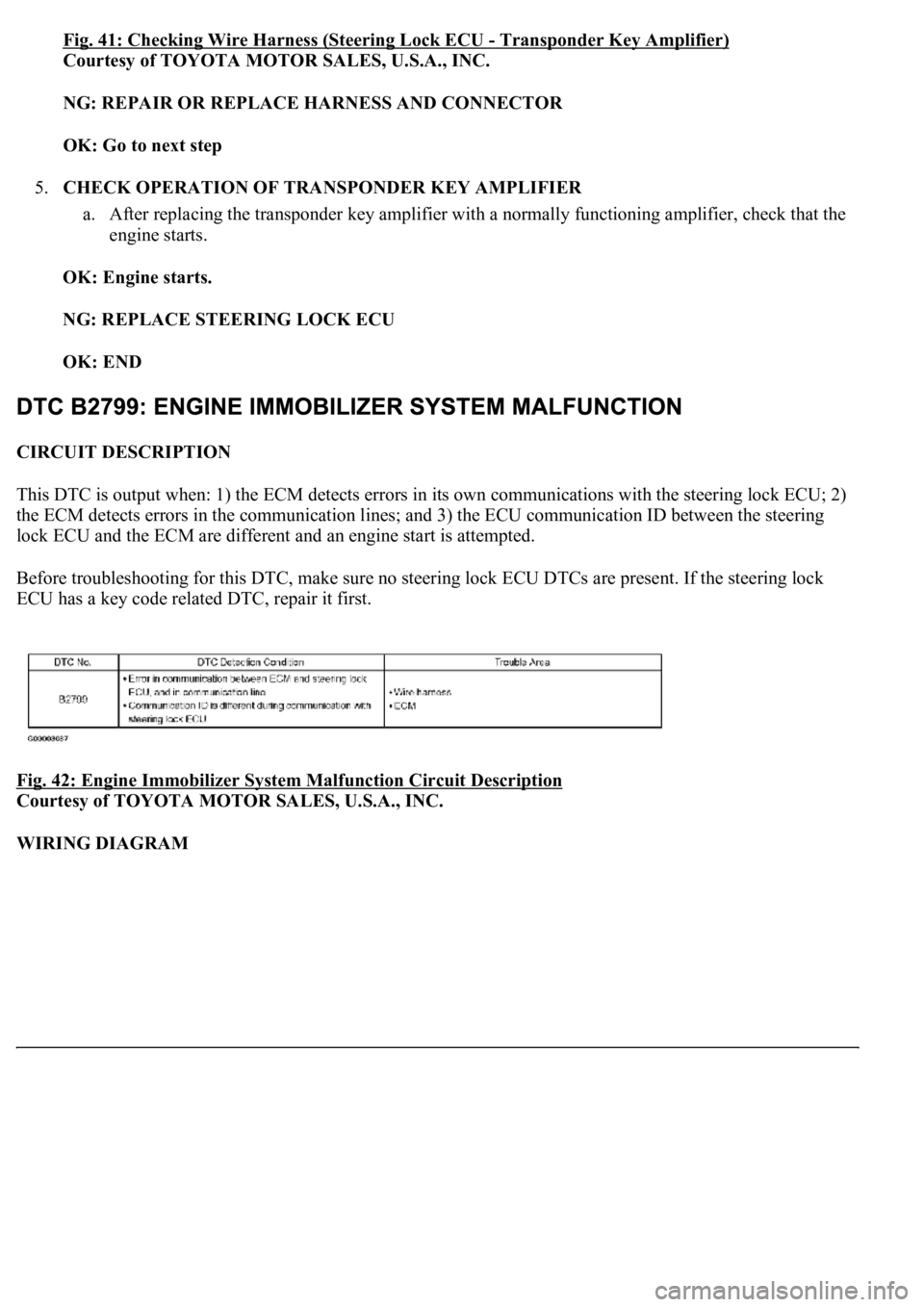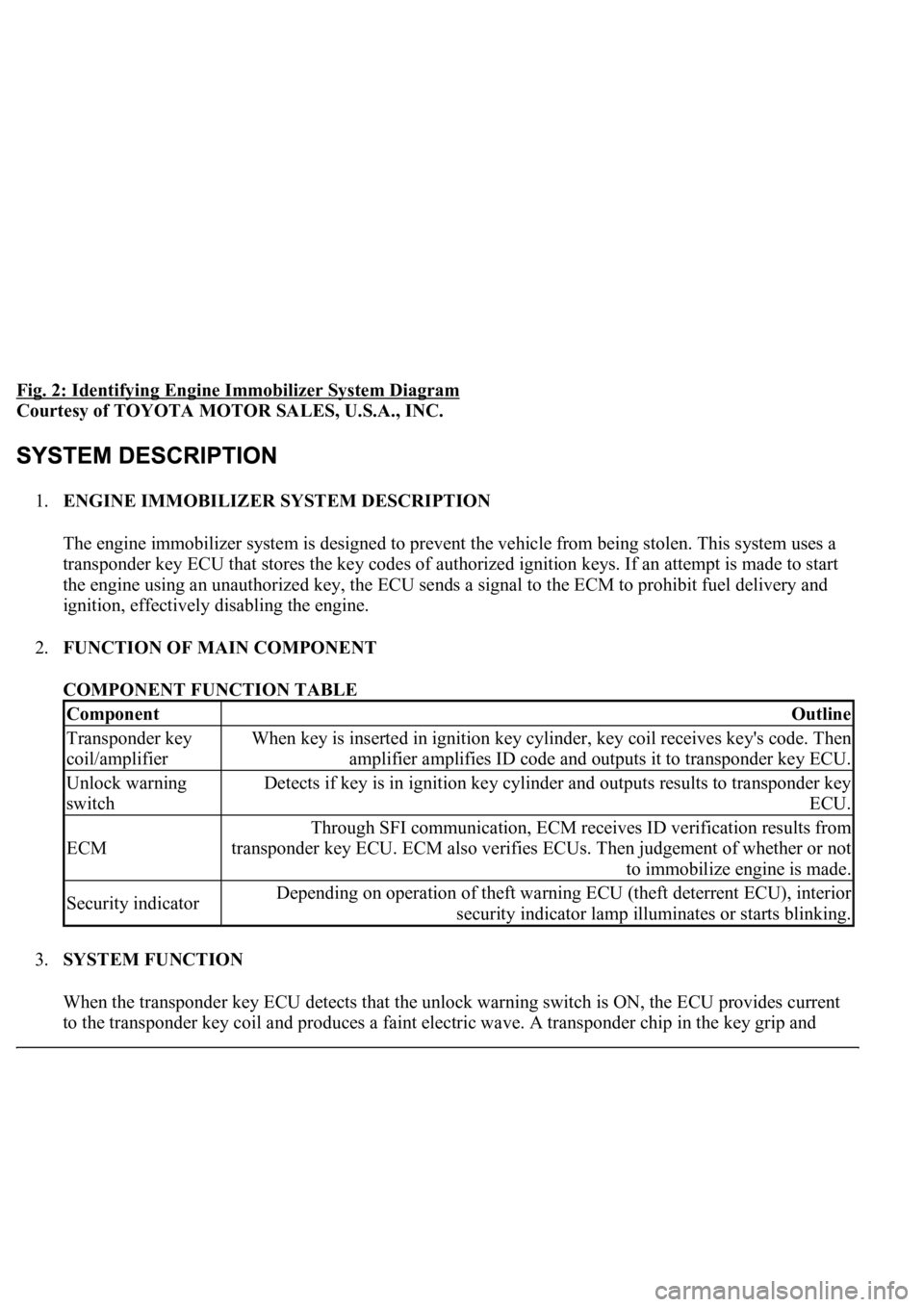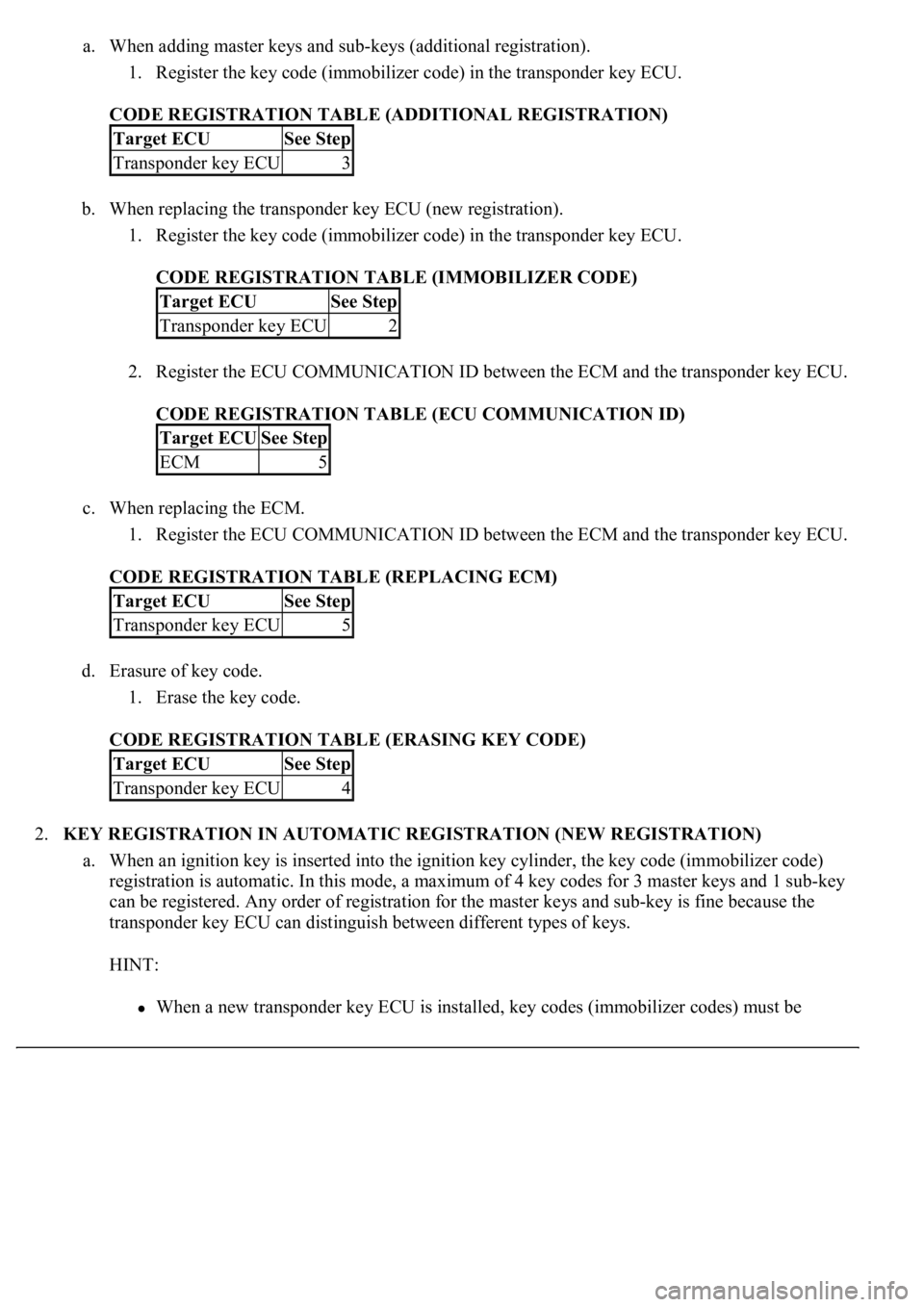Page 3215 of 4500
a. Using an oscilloscope or the hand-held tester check the waveform between the terminals of the T8
amplifier connector and S46 ECU connector. The waveform should be similar to the illustration on
the left.
OK: No noise is present (see Fig. 40
).
Fig. 40: Checking If Noise Is Present
Courtesy of TOYOTA MOTOR SALES, U.S.A., INC.
STEERING LOCK ECU - WAVEFORM TABLE
TOOL SETTING REFERENCE TABLE
NG: FIND CAUSE OF NOISE AND REMOVE IT
OK: Go to next step
4.CHECK WIRE HARNESS (STEERING LOCK ECU - TRANSPONDER KEY AMPLIFIER)
a. Disconnect the S46 ECU connector.
b. Disconnect the T8 amplifier connector.
c. Measure the resistance of the terminals of the connectors.
Tester connectionSpecified condition
S46-17 (CODE) - T8-4 (CODE)No noise is present
Tool Setting10 V/DIV., 20 ms/DIV.
ConditionIgnition switch OFF -> ON
Page 3216 of 4500
Standard:
STEERING LOCK ECU - TRANSPONDER KEY AMPLIFIER - RESISTANCE TABLE
Tester connectionSpecified condition
S46-17 (CODE) - T8-4 (CODE)Below 1 ohms
Page 3218 of 4500

Fig. 41: Checking Wire Harness (Steering Lock ECU -Transponder Key Amplifier)
Courtesy of TOYOTA MOTOR SALES, U.S.A., INC.
NG: REPAIR OR REPLACE HARNESS AND CONNECTOR
OK: Go to next step
5.CHECK OPERATION OF TRANSPONDER KEY AMPLIFIER
a. After replacing the transponder key amplifier with a normally functioning amplifier, check that the
engine starts.
OK: Engine starts.
NG: REPLACE STEERING LOCK ECU
OK: END
CIRCUIT DESCRIPTION
This DTC is output when: 1) the ECM detects errors in its own communications with the steering lock ECU; 2)
the ECM detects errors in the communication lines; and 3) the ECU communication ID between the steering
lock ECU and the ECM are different and an engine start is attempted.
Before troubleshooting for this DTC, make sure no steering lock ECU DTCs are present. If the steering lock
ECU has a key code related DTC, repair it first.
Fig. 42: Engine Immobilizer System Malfunction Circuit Description
Courtesy of TOYOTA MOTOR SALES, U.S.A., INC.
WIRING DIAGRAM
Page 3226 of 4500

Fig. 2: Identifying Engine Immobilizer System Diagram
Courtesy of TOYOTA MOTOR SALES, U.S.A., INC.
1.ENGINE IMMOBILIZER SYSTEM DESCRIPTION
The engine immobilizer system is designed to prevent the vehicle from being stolen. This system uses a
transponder key ECU that stores the key codes of authorized ignition keys. If an attempt is made to start
the engine using an unauthorized key, the ECU sends a signal to the ECM to prohibit fuel delivery and
ignition, effectively disabling the engine.
2.FUNCTION OF MAIN COMPONENT
COMPONENT FUNCTION TABLE
3.SYSTEM FUNCTION
When the transponder key ECU detects that the unlock warning switch is ON, the ECU provides current
to the transponder ke
y coil and produces a faint electric wave. A transponder chip in the key grip and
ComponentOutline
Transponder key
coil/amplifierWhen key is inserted in ignition key cylinder, key coil receives key's code. Then
amplifier amplifies ID code and outputs it to transponder key ECU.
Unlock warning
switchDetects if key is in ignition key cylinder and outputs results to transponder key
ECU.
ECM
Through SFI communication, ECM receives ID verification results from
transponder key ECU. ECM also verifies ECUs. Then judgement of whether or not
to immobilize engine is made.
Security indicatorDepending on operation of theft warning ECU (theft deterrent ECU), interior
security indicator lamp illuminates or starts blinking.
Page 3227 of 4500

receives the faint electric wave. Upon receiving the faint electric wave, the transponder chip outputs a key
ID code signal. The transponder key coil receives this signal, the transponder key amplifier amplifies it,
and then the signal is transmitted to the ECU.
The ECU matches the key's ID code with the vehicle's ID code, which was previously registered in the
ECU, and then communicates the results to the ECM using SFI communication.
After the identification results show that the key's ID code matches the vehicle's ID code and the ECU has
confirmed their match: 1) the immobilizer system does not immobilize the engine and the engine starting
controls (fuel injection control and ignition control) enter standby mode; and 2) the ECU transmits a
security indicator signal that communicates "indicator off" to the theft warning ECU (theft deterrent
ECU). Then, the theft warning ECU turns off the security indicator lamp.
HINT:
<00380056004800030057004b004c00560003005300550052004600480047005800550048000300570052000300570055005200580045004f00480056004b00520052005700030057004b0048000300480051004a004c005100480003004c00500050005200
45004c004f004c005d0048005500030056005c005600570048[m. The hand-held tester should be used in steps
4, 5 and 7.
1.VEHICLE BROUGHT TO WORKSHOP
2.CUSTOMER PROBLEM ANALYSIS CHECK AND SYMPTOM CHECK (See CUSTOMER
PROBLEM ANALYSIS CHECK )
3.CRANK ENGINE FOR MORE THAN 10 SECONDS
4.CHECK FOR DTCS
a. Check for DTCs and note any codes that are output.
b. Delete the DTC.
c. Recheck for DTCs. Based on the DTC output in (a), try to force output of the same SFI system
DTC or engine immobilizer system DTC by simulating the operation indicated by the DTC.
1. If the DTC does not reoccur, proceed to A.
2. If the SFI system DTC reoccurs, proceed to B.
3. If the engine immobilizer system DTC reoccurs, proceed to C.
B: Go to SFI SYSTEM (See DIAGNOSTIC TROUBLE CODE CHART
)
C: Go to step 8
A: Go to next step
5.READ DATA LIST USING HAND-HELD TESTER
a. Connect the hand-held tester to the Controller Area Network Vehicle Interface Module (CAN
VIM). Then connect the CAN VIM to the DLC3.
b. Turn the ignition switch ON and push the hand-held tester main switch ON.
c. Read the DATA LIST.
Page 3228 of 4500
Transponder key ECU assy:
Fig. 3: Transponder Key ECU Assy Data List
Courtesy of TOYOTA MOTOR SALES, U.S.A., INC.
OK: "ON" (Key is in ignition key cylinder) appears on the screen.
NG: See DTC B2780 PUSH SWITCH/KEY UNLOCK WARNING SWITCH MALFUNCTION
)
OK: Go to next step
6.See PROBLEM SYMPTOMS TABLE
)
a. If the fault is not listed on the problem symptoms table, proceed to A.
b. If the fault is listed on the problem symptoms table, proceed to B.
B: Go to step 8
A: Go to next step
7.OVERALL ANALYSIS AND TROUBLESHOOTING
a. DATA LIST/ACTIVE TEST (see DATA LIST/ACTIVE TEST
)
1. Inspection with the hand-held tester (DATA LIST)
2. Inspection with the hand-held tester (ACTIVE TEST)
b. See TERMINALS OF ECU
)
8.ADJUST, REPAIR OR REPLACE
9.CONFIRMATION TEST
END
Page 3229 of 4500
Fig. 4: Identifying Customer Problem Analysis Check
Courtesy of TOYOTA MOTOR SALES, U.S.A., INC.
HINT:
The key has 2 codes: the key code (immobilizer code) and wireless code. All of these code types need to be
registered. Refer to REGISTRATION
for the wireless code registration procedures.
1.DESCRIPTION OF CODE REGISTRATION
Page 3230 of 4500

a. When adding master keys and sub-keys (additional registration).
1. Register the key code (immobilizer code) in the transponder key ECU.
CODE REGISTRATION TABLE (ADDITIONAL REGISTRATION)
b. When replacing the transponder key ECU (new registration).
1. Register the key code (immobilizer code) in the transponder key ECU.
CODE REGISTRATION TABLE (IMMOBILIZER CODE)
2. Register the ECU COMMUNICATION ID between the ECM and the transponder key ECU.
CODE REGISTRATION TABLE (ECU COMMUNICATION ID)
c. When replacing the ECM.
1. Register the ECU COMMUNICATION ID between the ECM and the transponder key ECU.
CODE REGISTRATION TABLE (REPLACING ECM)
d. Erasure of key code.
1. Erase the key code.
CODE REGISTRATION TABLE (ERASING KEY CODE)
2.KEY REGISTRATION IN AUTOMATIC REGISTRATION (NEW REGISTRATION)
a. When an ignition key is inserted into the ignition key cylinder, the key code (immobilizer code)
registration is automatic. In this mode, a maximum of 4 key codes for 3 master keys and 1 sub-key
can be registered. Any order of registration for the master keys and sub-key is fine because the
transponder key ECU can distinguish between different types of keys.
HINT:
When a new transponder key ECU is installed, key codes (immobilizer codes) must be
Target ECUSee Step
Transponder key ECU3
Target ECUSee Step
Transponder key ECU2
Target ECUSee Step
ECM5
Target ECUSee Step
Transponder key ECU5
Target ECUSee Step
Transponder key ECU4